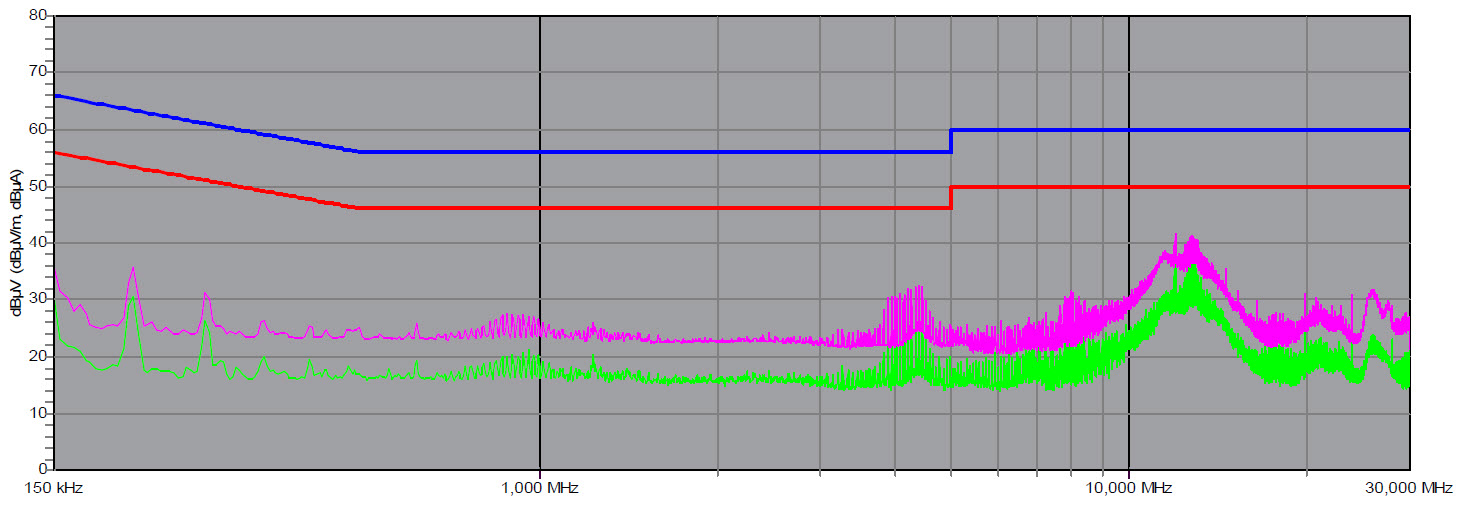EVGA SuperNOVA 750 G5 Power Supply Review
The SuperNOVA 750 G5 is fully modular, compact, and promises for high performance. Will it be able to meet the popular Corsair and Seasonic offerings though?
Why you can trust Tom's Hardware
Advanced Transient Response Tests
For details about our transient response testing, please click here.
In the real world, power supplies are always working with loads that change. It's of immense importance, then, for the PSU to keep its rails within the ATX specification's defined ranges. The smaller the deviations, the more stable your PC will be with less stress applied to its components.
We should note that the ATX spec requires capacitive loading during the transient rests, but in our methodology, we also choose to apply a worst case scenario with no additional capacitance on the rails.
Advanced Transient Response at 20% – 200ms
| Voltage | Before | After | Change | Pass/Fail |
|---|---|---|---|---|
| 12V | 12.078V | 11.949V | 1.07% | Pass |
| 5V | 4.927V | 4.809V | 2.39% | Pass |
| 3.3V | 3.309V | 3.141V | 5.08% | Pass |
| 5VSB | 4.902V | 4.857V | 0.92% | Pass |
Advanced Transient Response at 20% – 20ms
| Voltage | Before | After | Change | Pass/Fail |
|---|---|---|---|---|
| 12V | 12.079V | 11.904V | 1.45% | Pass |
| 5V | 4.931V | 4.791V | 2.84% | Pass |
| 3.3V | 3.309V | 3.108V | 6.07% | Fail |
| 5VSB | 4.907V | 4.836V | 1.45% | Pass |
Advanced Transient Response at 20% – 1ms
| Voltage | Before | After | Change | Pass/Fail |
|---|---|---|---|---|
| 12V | 12.078V | 11.962V | 0.96% | Pass |
| 5V | 4.931V | 4.790V | 2.86% | Pass |
| 3.3V | 3.309V | 3.100V | 6.32% | Fail |
| 5VSB | 4.906V | 4.806V | 2.04% | Pass |
Advanced Transient Response at 50% – 200ms
| Voltage | Before | After | Change | Pass/Fail |
|---|---|---|---|---|
| 12V | 12.065V | 11.937V | 1.06% | Pass |
| 5V | 4.923V | 4.806V | 2.38% | Pass |
| 3.3V | 3.304V | 3.138V | 5.02% | Fail |
| 5VSB | 4.887V | 4.836V | 1.04% | Pass |
Advanced Transient Response at 50% – 20ms
| Voltage | Before | After | Change | Pass/Fail |
|---|---|---|---|---|
| 12V | 12.065V | 11.873V | 1.59% | Pass |
| 5V | 4.923V | 4.782V | 2.86% | Pass |
| 3.3V | 3.304V | 3.104V | 6.05% | Fail |
| 5VSB | 4.886V | 4.788V | 2.01% | Pass |
Advanced Transient Response at 50% – 1ms
| Voltage | Before | After | Change | Pass/Fail |
|---|---|---|---|---|
| 12V | 12.065V | 11.942V | 1.02% | Pass |
| 5V | 4.923V | 4.786V | 2.78% | Pass |
| 3.3V | 3.304V | 3.098V | 6.23% | Fail |
| 5VSB | 4.884V | 4.786V | 2.01% | Pass |
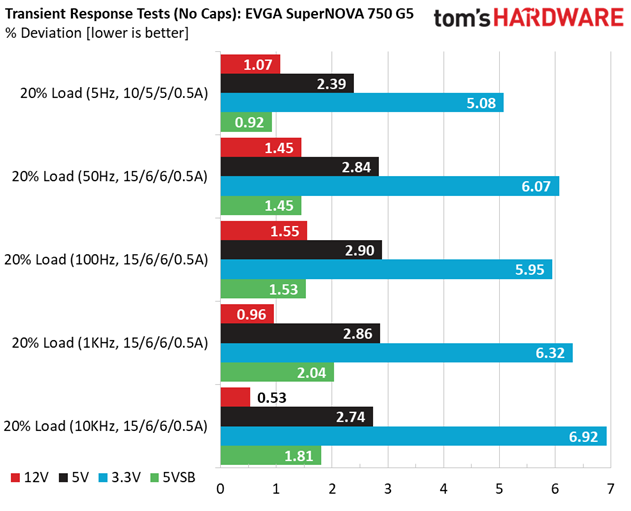



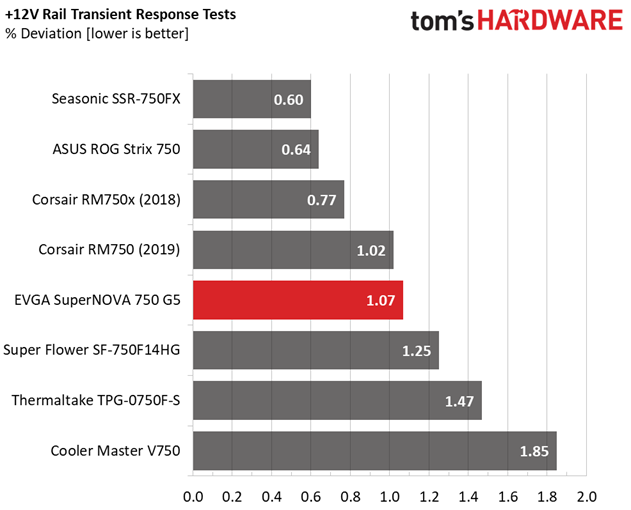
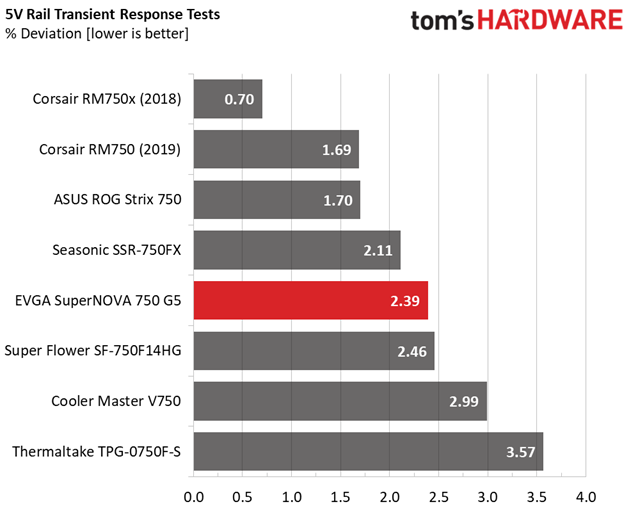
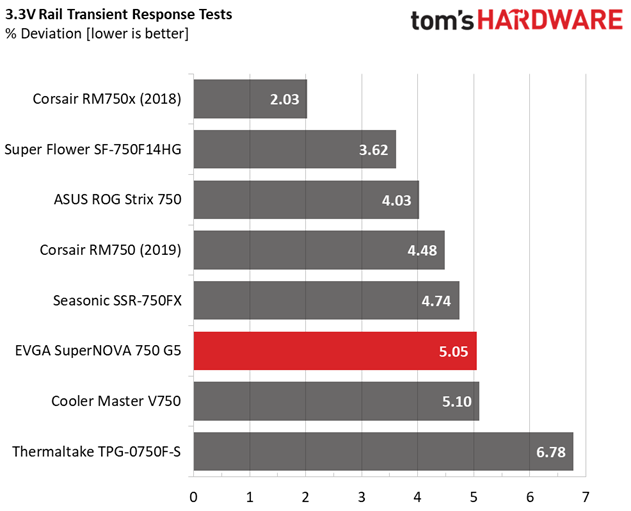
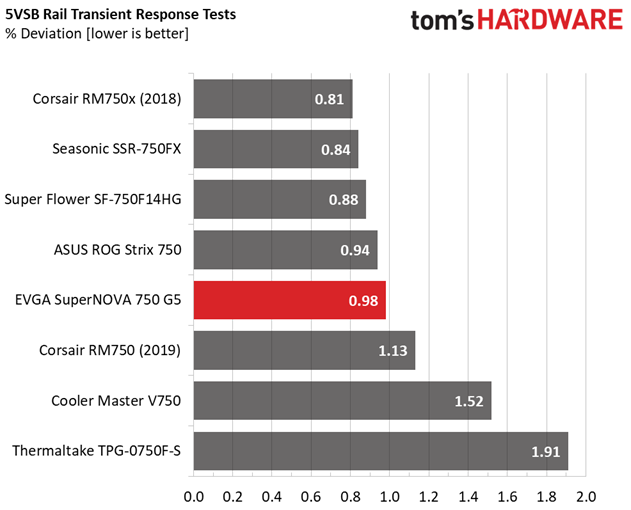
The 3.3V rail's performance is disappointing. The +12V rail should also stay within 1% in all tests.
Turn-On Transient Tests
In the next set of tests, we measure the PSU's response in simpler transient load scenarios—during its power-on phase. Ideally, we don't want to see any voltage overshoots or spikes since those put a lot of stress on the DC-DC converters of installed components.
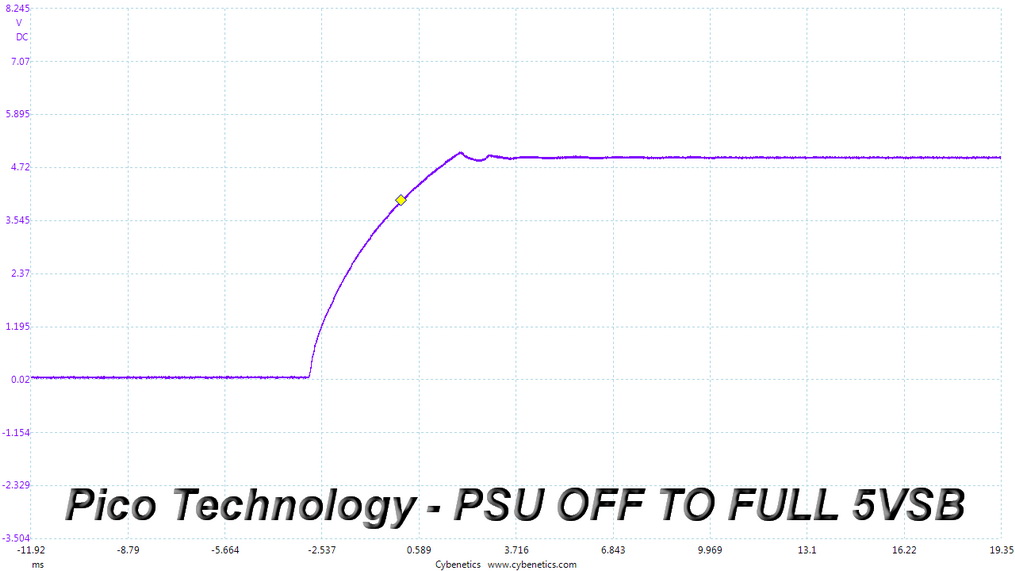
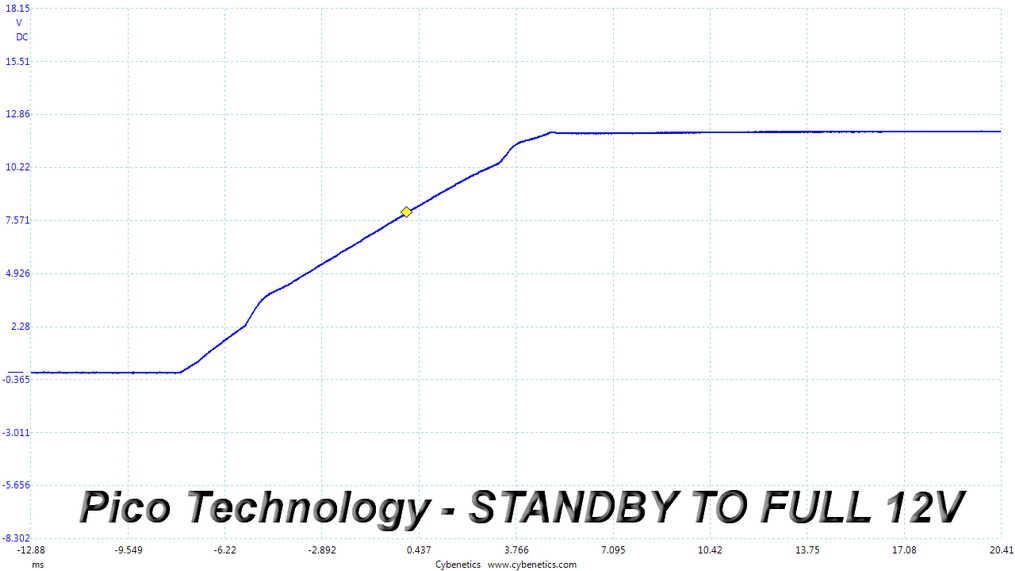
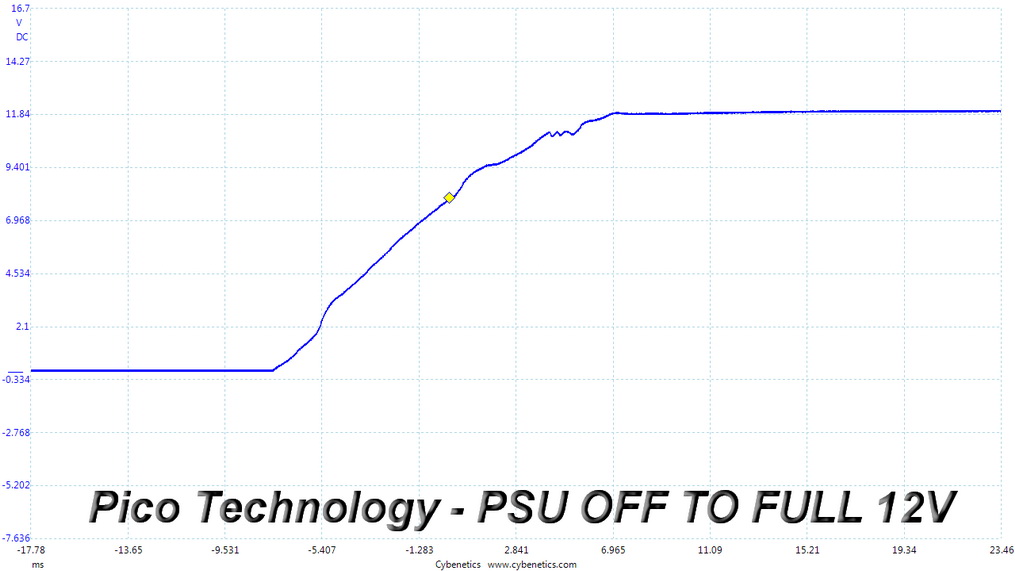
A small voltage overshoot at 5VSB, which is nothing to worry about.
Power Supply Timing Tests
There are several signals generated by the power supply, which need to be within specified, by the ATX spec, ranges. If they are not, there can be compatibility issues with other system parts, especially mainboards. From year 2020, the PSU's Power-on time (T1) has to be lower than 150ms and the PWR_OK delay (T3) from 100 to 150ms.
Get Tom's Hardware's best news and in-depth reviews, straight to your inbox.
| T1 (Power-on time) & T3 (PWR_OK delay) | ||
|---|---|---|
| Load | T1 | T3 |
| 20% | 60ms | 294ms |
| 50% | 68ms | 294ms |
The PWR_OK delay is our of the 100-150ms region, so the PSU does not support the alternative sleep mode, which will be a requirement by the ATX v2.52 from 2020.
Ripple Measurements
Ripple represent the AC fluctuations (periodic) and noise (random) found in the PSU's DC rails. This phenomenon significantly decreases the capacitors' lifespan because it causes them to run hotter. A 10-degree Celsius increase can cut into a cap's useful life by 50%. Ripple also plays an important role in overall system stability, especially when overclocking is involved.
The ripple limits, according to the ATX specification, are 120mV (+12V) and 50mV (5V, 3.3V, and 5VSB).
| Test | 12V | 5V | 3.3V | 5VSB | Pass/Fail |
|---|---|---|---|---|---|
| 10% Load | 12.4 mV | 5.6 mV | 12.0 mV | 7.1 mV | Pass |
| 20% Load | 10.0 mV | 6.0 mV | 12.2 mV | 7.1 mV | Pass |
| 30% Load | 10.4 mV | 6.8 mV | 12.9 mV | 7.7 mV | Pass |
| 40% Load | 13.7 mV | 7.1 mV | 14.1 mV | 8.1 mV | Pass |
| 50% Load | 14.4 mV | 6.6 mV | 15.8 mV | 8.4 mV | Pass |
| 60% Load | 15.7 mV | 6.9 mV | 16.8 mV | 8.8 mV | Pass |
| 70% Load | 18.0 mV | 7.9 mV | 19.4 mV | 9.7 mV | Pass |
| 80% Load | 18.3 mV | 8.8 mV | 22.2 mV | 9.9 mV | Pass |
| 90% Load | 21.5 mV | 9.8 mV | 25.3 mV | 10.7 mV | Pass |
| 100% Load | 25.4 mV | 13.8 mV | 35.2 mV | 18.8 mV | Pass |
| 110% Load | 27.1 mV | 15.0 mV | 42.2 mV | 21.2 mV | Pass |
| Crossload 1 | 8.0 mV | 7.5 mV | 16.8 mV | 9.2 mV | Pass |
| Crossload 2 | 24.8 mV | 11.7 mV | 27.8 mV | 14.6 mV | Pass |
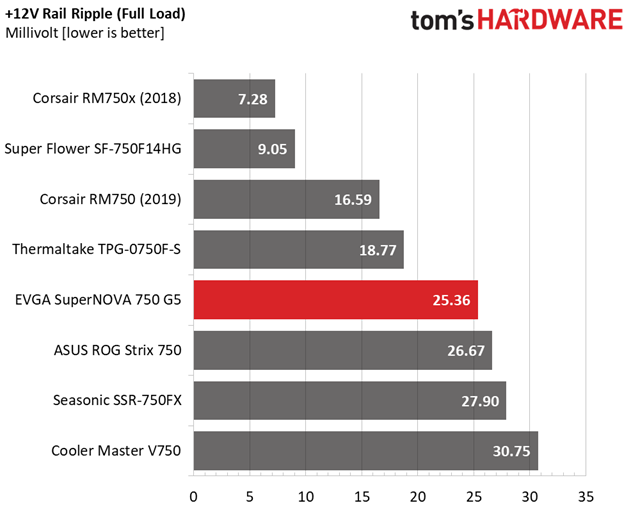
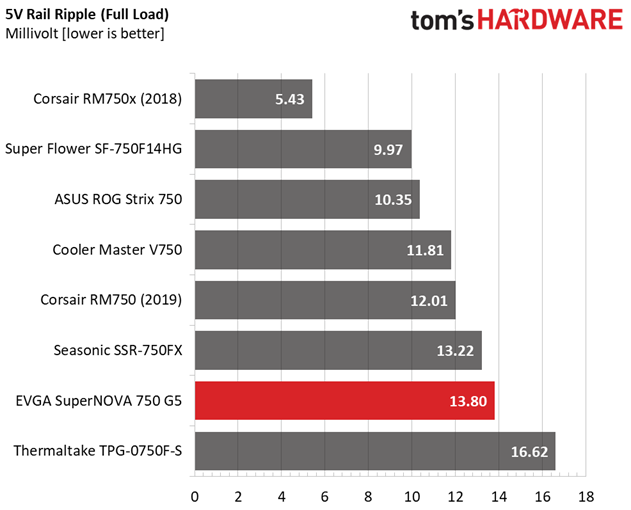

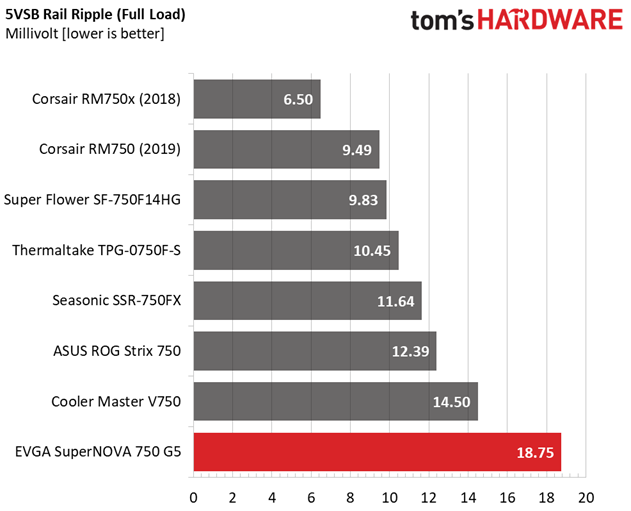
The ripple suppression is good on all rails but the 3.3V, where there is a large increase in the 100% and 110% load tests.
Ripple At Full Load
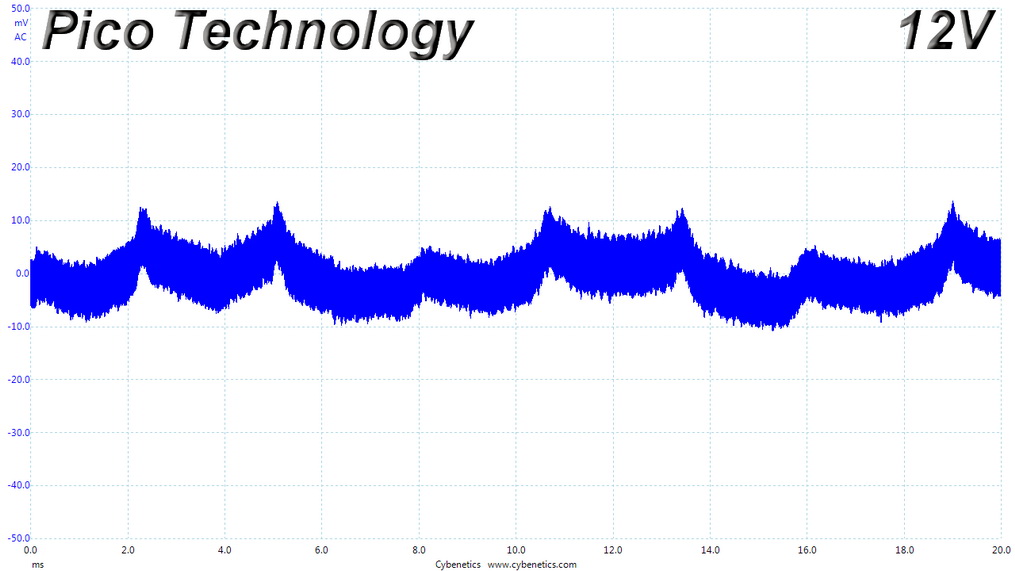


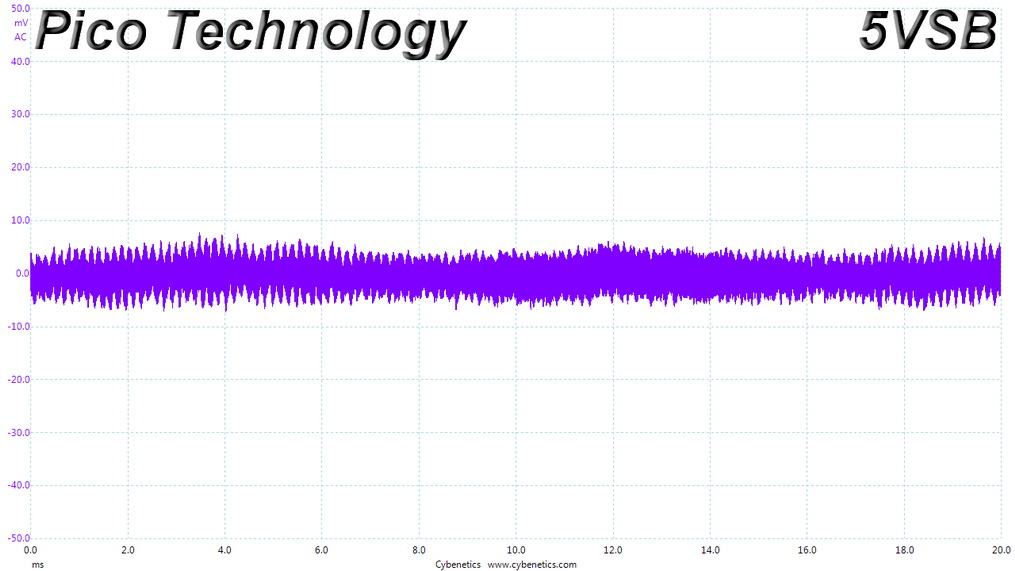
Ripple At 110% Load
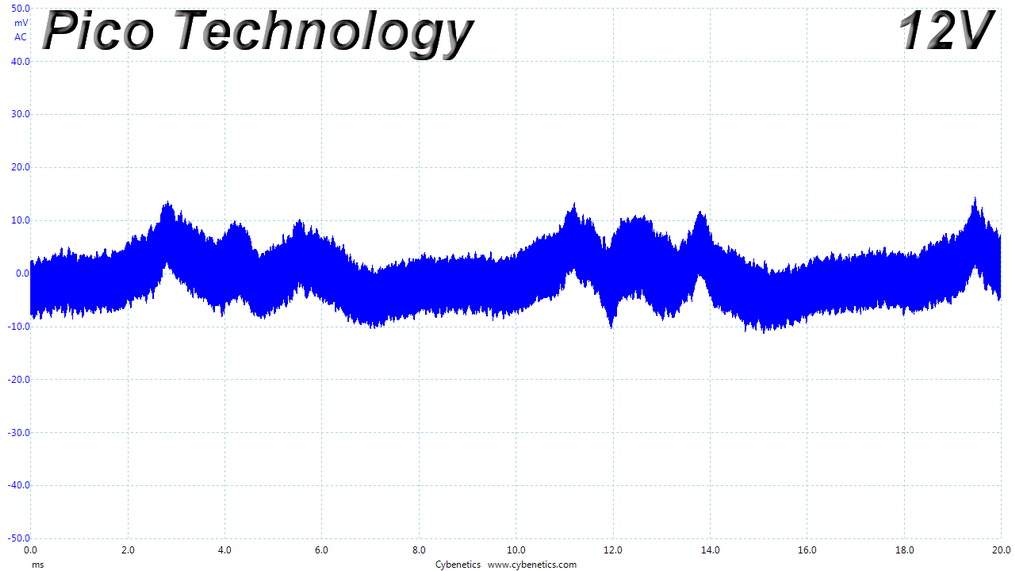
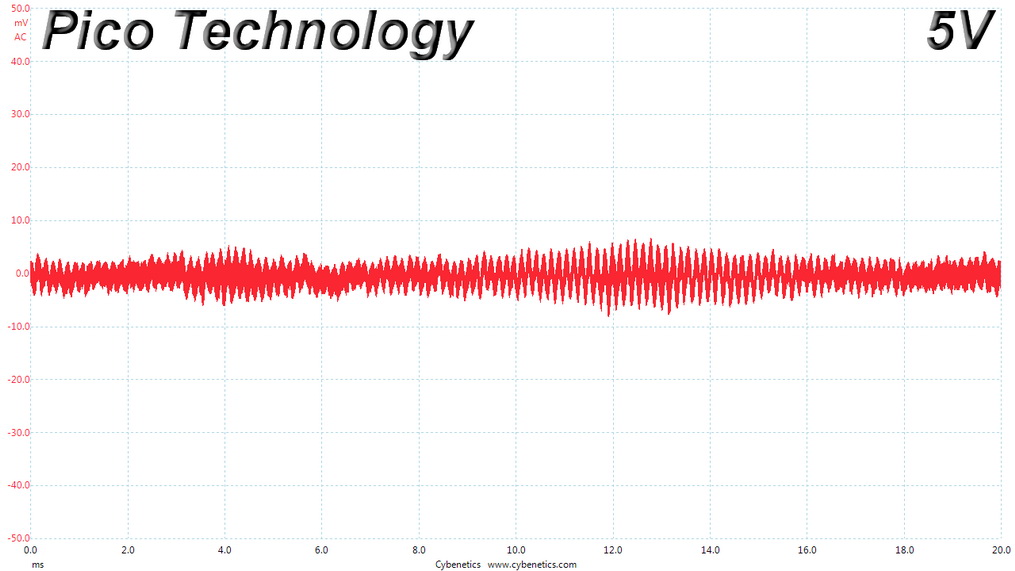

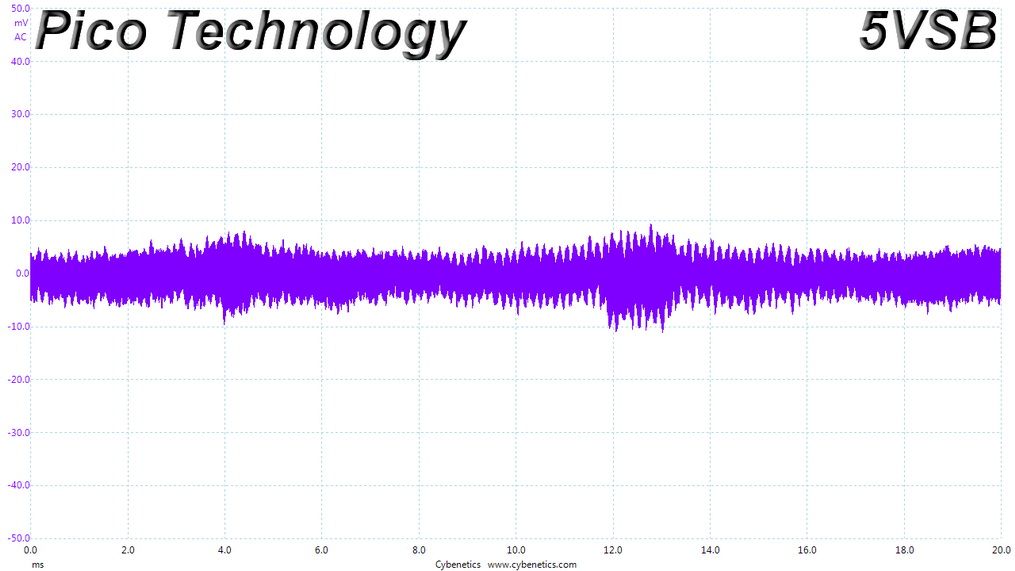
Ripple At Cross-Load 1


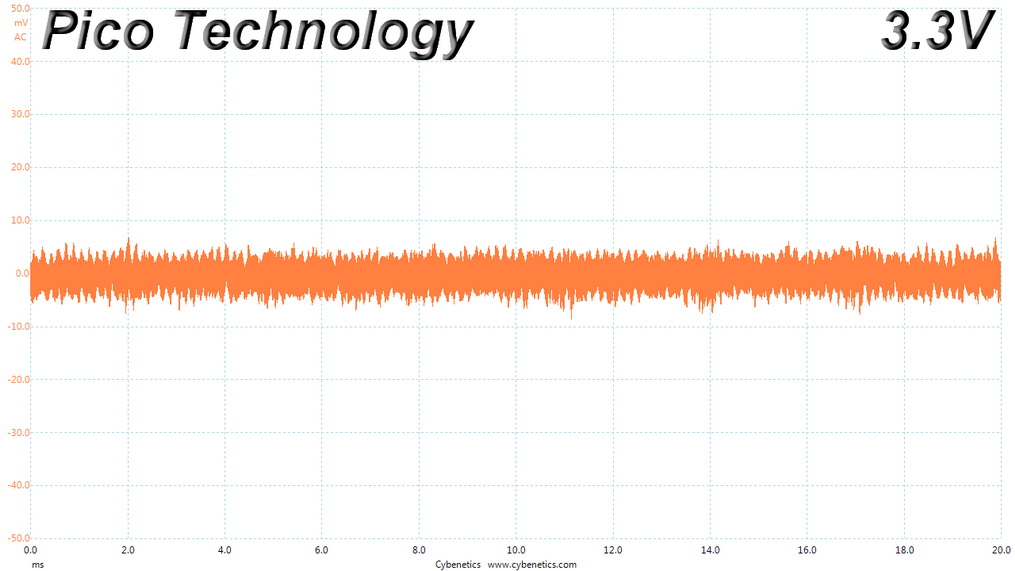
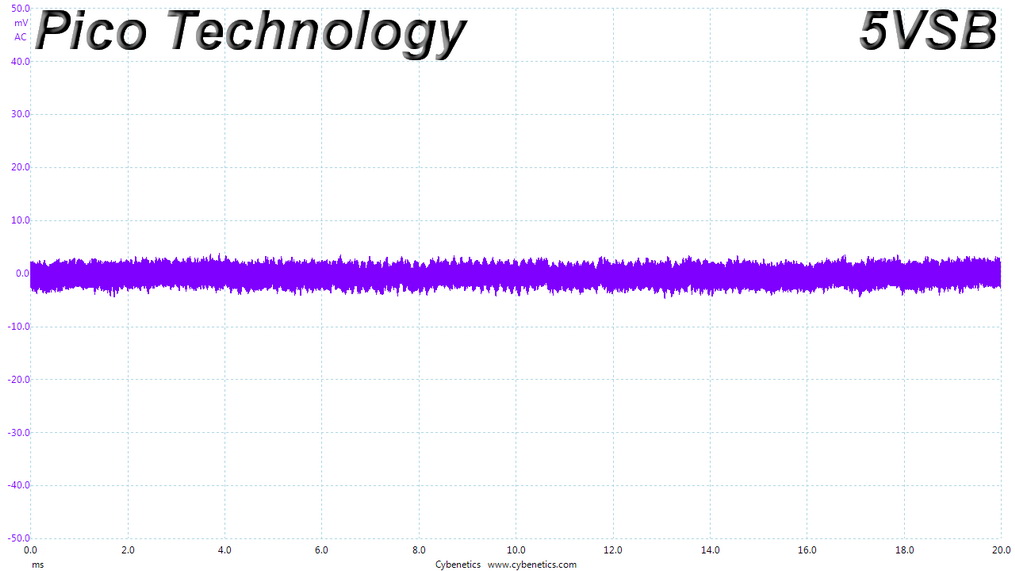
Ripple At Cross-Load 2
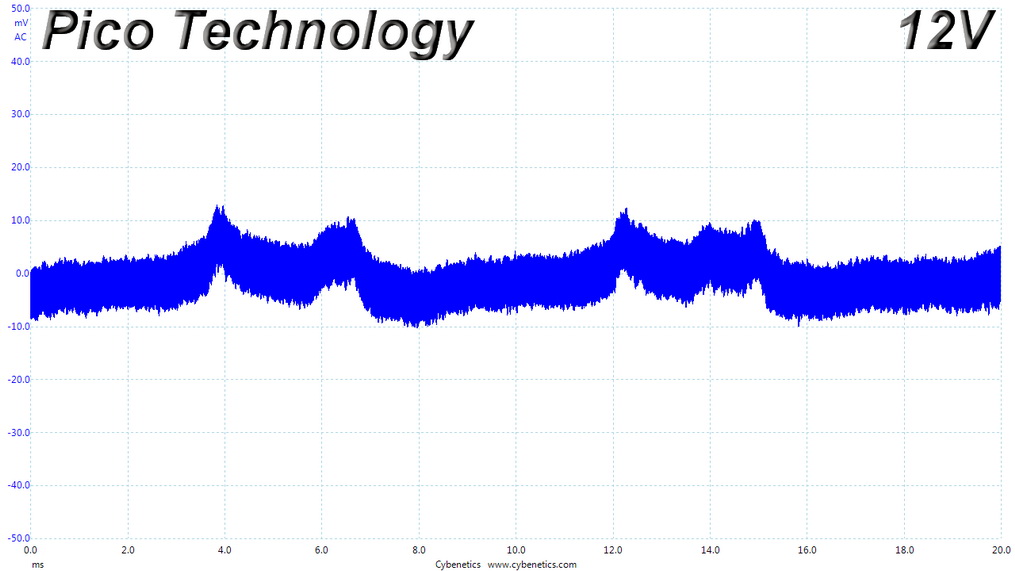
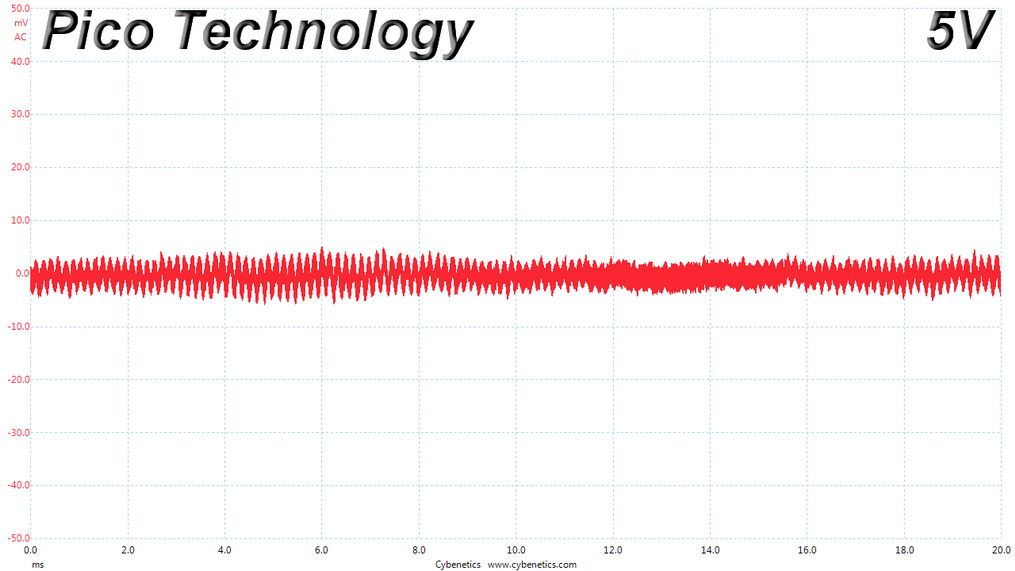
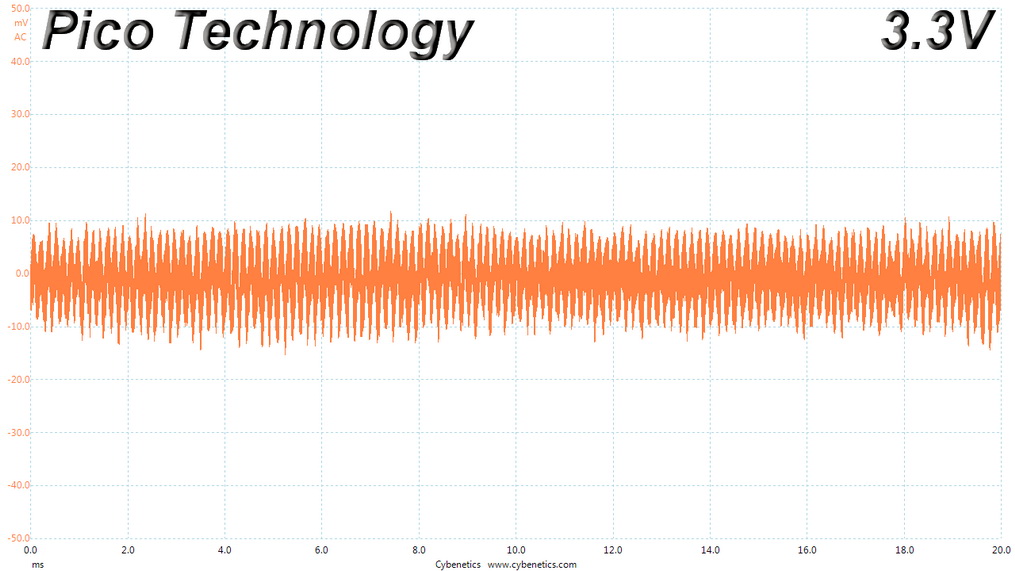
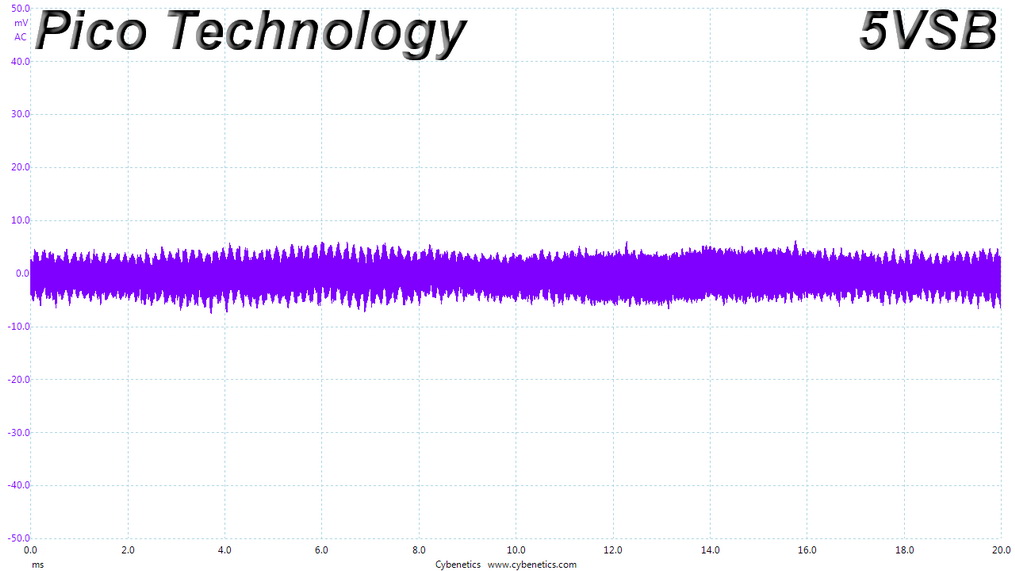
EMC Pre-Compliance Testing – Average & Peak EMI Detector Results
Electromagnetic Compatibility (EMC) is the ability of a device to operate properly in its environment without disrupting the proper operation of other close-by devices.
Electromagnetic Interference (EMI) stands for the electromagnetic energy a device emits, and it can cause problems in other close-by devices if too high. For example, it can be the cause of increased static noise in your headphones or/and speakers.
No spurs exceed the limits.
MORE: Best Power Supplies
MORE: How We Test Power Supplies
MORE: All Power Supply Content
Current page: Transient Response Tests, Timing Tests, Ripple Measurements and EMC Pre-Compliance Testing
Prev Page Protection Features, DC Power Sequencing, Cross-Load Tests and Infrared Images Next Page Performance, Noise and Efficiency
Aris Mpitziopoulos is a contributing editor at Tom's Hardware, covering PSUs.
-
Yuniel Hello Aris , you still recommened the g3 ? , beacuse aparently is in tier Tier D - Not recommended https://linustechtips.com/main/topic/1116640-psu-tier-list-40-rev-103/ , beacuse of OPP , the 850 g3 is good PSU for high end PC gaming ?Reply -
mossberg ReplyYuniel said:Hello Aris , you still recommened the g3 ? , beacuse aparently is in tier Tier D - Not recommended https://linustechtips.com/main/topic/1116640-psu-tier-list-40-rev-103/ , beacuse of OPP , the 850 g3 is good PSU for high end PC gaming ?
That list is a joke. -
agentlaidlaw Reply
linus forums are spreading fear mongering. they use toms own reviews about the G3 series as their reasoning while simultaneously ignoring toms still recommendation for it IN THOSE SAME REVIEWS. they all of a sudden don't care about the authors opinion. they pick and choose what they want to hear and spread misinformation and instill paranoia and fear mongering into people. and also flat-out ignore jonnyguru reviews for it as well. while simultaneously using jonny's reviews for recommending other power supplies.Yuniel said:Hello Aris , you still recommened the g3 ? , beacuse aparently is in tier Tier D - Not recommended https://linustechtips.com/main/topic/1116640-psu-tier-list-40-rev-103/ , beacuse of OPP , the 850 g3 is good PSU for high end PC gaming ?
do yourself a favor and ignore that dumb list. the guy who took control of it is going on a fear mongering spree and has admitted hes basing everything off his own opinion rather than facts. he doesn't like single rails and telling people single rails will blow up on them if you use them in units past 600 watts or so. he's not correcting users going around on that forum stating single rails don't support ocp / opp. he's spreading misinformation about a plethora of power supplies, hes ranking power supplies that are objectively worse over nitpicking stuff. like the g3 opp that's only a concern if you ARE ALREADY PUSHING THE POWER SUPPLY BEYOND ITS RATED SPEC NO MATTER WHAT EVEN WITH GOOD OPP YOU WILL STILL HAVE PROBLEMS IN THOSE SCENARIOS OVER TIME OF CONSTANT PUSHING OVER SPEC.
sorry for my rant but linus power supply tier has been the worse thing to come about in the community. -
WigitMigit Could I download evga's software and adjust the fan curve to deal with the loud fan issue? Or does their software not work with the g5 lineupReply -
TJ Hooker Reply
What software are you referring to? I've never heard of software that lets you change your PSU fan profile, except for Corsair link (which only works with a few of their high end PSUs).WigitMigit said:Could I download evga's software and adjust the fan curve to deal with the loud fan issue? Or does their software not work with the g5 lineup -
WigitMigit Reply
https://www.evga.com/supernova/TJ Hooker said:What software are you referring to? I've never heard of software that lets you change your PSU fan profile, except for Corsair link (which only works with a few of their high end PSUs). -
TJ Hooker Reply
Interesting, didn't realize EVGA had something similar. But it looks like it works only with that one PSU model from ~7 years ago, guess it's not too surprising I hadn't heard of it.WigitMigit said:https://www.evga.com/supernova/ -
VTEC_Inside There is an issue with this review IMO.Reply
Active Clamp Reset Forward designs characteristically hold steady voltages better.
The criticism regarding transient response is flawed in that it is not tested the way that people are actually going to use the things, ie with the caps in place.
While I'm sure no one is stamping an official seal of approval on PSUs, I'd imagine they'd be ripped on pretty hard if it didn't actually adhere to ATX specifications.
Evga's marketing wank goes on about the higher quality capacitors on the output board. A more useful test, IMO, would be to test that transient response under conditions that people are actually using the thing. Given that it only slightly failed this testing methodology without the caps, I'm left to believe that it would do just fine tested in a real world situation.
